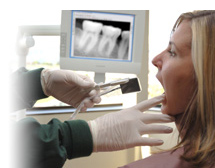ServicesWe are pleased to offer the following services and technologies to our patients:
ORAL HYGIENE CAREMaintaining good oral hygiene is one of the most important things you can do for your teeth and gums. Healthy teeth not only enable you to look and feel good, they make it possible to eat and speak properly. Good oral health is important to your overall well-being. Daily preventive care, including proper brushing and flossing, will help stop problems before they develop. In between regular visits to the dentist, there are simple steps that each of us can take to greatly decrease the risk of developing tooth decay, gum disease and other dental problems. These include: 
The following are indications of good oral hygiene:

SEALANTSSealants are used to fill narrow grooves in a tooth that cannot be adequately cleaned by brushing. In some cases, the tooth structure has fine grooves or pits which accumulate plaque, not because the person doesn't brush, but because they're too narrow to allow even one bristle into them. To avoid cavities developing over time, the dentist will brush on a coating that seals the grooves and pits, making it possible to brush off all the plaque and keep your teeth healthy. Back to topBONDINGBonding involves adhering composite resin material that is matched to the color of the tooth, to the front of the tooth. This is performed to repair damage caused by decay, to alter the alignment of the tooth, close gaps between the teeth, or for other cosmetic purposes. First the surface of the tooth is roughened in order to accept the bonding. A gel is applied so the resin will adhere to the surface of the tooth. The composite is then placed on the tooth and the bonding agent hardens with intense light. The last step is shaping and polishing to give a lustrous finish. Back to topFILLINGSA filling is a way to restore a tooth damaged by decay back to its normal function and shape. If you have a tooth that requires a filling, the dentist will first remove the decayed tooth material, clean the affected area, and then fill the cleaned out cavity with a filling material. A filling helps prevent further decay by closing off any cracks or spaces where bacteria can enter. There are a variety of filling materials available including gold, silver, plastic and porcelain. The dentist will work with you to determine which material is best, depending on the extent of repair, where in the filling is needed, and cost. Each filling material is briefly explained below: 
If decay or a fracture has damaged a large portion of the tooth, a crown (or 'cap') may be recommended. Decay that has reached the nerve may be treated through root canal therapy or through a procedure called pulp capping. Back to topCROWNS AND BRIDGESCrowns and bridges are used to restore and enhance teeth that are damaged or to take the place of missing teeth. A crown (also referred to as a cap) is used to entirely cover a damaged tooth. A crown not only strengthens a tooth, but it can dramatically improve a tooth’s appearance, shape and alignment. 
Crowns may be used to:
A bridge is an ideal method to fill the space created by missing teeth. A bridge is one or more artificial teeth cemented into place using the teeth on either side for support. This is an option for filling the space created by a missing tooth. Bridge work is as much an art as it is an exact science since it replaces a missing tooth both functionally and cosmetically. The materials used may be gold alloys, porcelain bonded to metal alloy, or all ceramic material made to match your natural tooth color. The choice of material depends on requirements for strength, wear, and aesthetics. It is important that a missing tooth be replaced as soon as possible. If not treated, the teeth surrounding the gap begin to shift inward. Since teeth use their neighbors for support, if one is missing they begin to 'fall” and shift into the open spaces. This may worsen the bite because of the changes in pressure and can eventually result in problems with the jaw such as TMJ. Bridges and crowns are made by first taking an impression of your mouth. The impression is sent to a dental lab where your crown or bridge will be custom made to fit your mouth and match your natural tooth color. A temporary crown or bridge will be placed into your mouth until your permanent crown or bridge is ready and cemented into place. Bridges and crowns are very durable and can last a lifetime with extra care and good oral hygiene. Back to top
DENTURESA denture is a removable replacement for missing teeth and surrounding tissues. There are two types of dentures available, including partial and complete dentures. Partial dentures are used when some natural teeth remain, while complete dentures are used to completely replace all teeth. Dentures are made to resemble your natural teeth so there should be no noticeable change to your appearance. In fact, dentures may even improve your smile! This restoration method is used to restore your smile and mouth function if all your teeth have been lost. The dentures are custom created to resemble natural teeth and are positioned to take the place of natural teeth. Complete dentures are removable and may require adjustments in order to create a proper fit with the gums and mouth. A removable partial denture is a device used when one or more natural teeth still remain in the upper or lower jaw. They usually consist of replacement teeth attached to a gum-colored plastic base which is held in place in the mouth. A fixed partial denture acts the same as a removable denture, but it is cemented into place using adjacent teeth for support. New dentures may feel awkward or loose for the first few weeks until the muscles of your cheek and tongue learn to keep them in place and you are comfortable eating and speaking. Although this may require some practice you will adjust and enjoy the benefits a full mouth of teeth can provide. Back to top
TOOTH EXTRACTIONSGood oral hygiene should always be practiced since the loss of a single tooth can have major impact upon your oral health and appearance. Although dentists will use every measure to prevent tooth loss, there are still sometimes necessary occasions when a tooth may need to be extracted. A tooth may need to be extracted for the following reasons:
After careful examination and treatment, the dentist may advise to have a tooth extracted. Before a tooth is removed, the dentist will take an x-ray in order to understand the shape and position of the tooth and surrounding bone. Based on the degree of difficulty, we may refer you to a specialized oral surgeon. For a simple extraction, we will first apply a local anesthetic to prevent pain and discomfort. The tooth will be loosened with a tool called an elevator and then removed with dental forceps. Once the procedure is complete, the area may be closed with one or two stitches. We will then provide you with care instructions to alleviate discomfort and ensure proper healing. Back to topWISDOM TOOTH EXTRACTIONSWisdom teeth are the last molars or “third molars” that develop on each side of the jaws. Wisdom teeth usually emerge in the back of the mouth between the ages of 16-20. Wisdom teeth are a valuable asset to the mouth when they are healthy and properly positioned. Often, however, problems develop that require their removal. When the jaw isn't large enough to accommodate wisdom teeth, they can become impacted (unable to come in or misaligned). Wisdom teeth may also grow in sideways, emerge only part way through the gum or remain trapped beneath the gum and bone. A wisdom tooth extraction is a relatively routine procedure. The dentist will numb the area in your mouth with a local anesthesia or use IV sedation so you are asleep during the procedure. After the tooth is removed, we will provide care instructions to ensure proper healing. Some pain and swelling may occur but will normally subside after a few days. You should call your dentist if you have prolonged or severe pain, swelling, bleeding or fever. Back to top
NIGHTGUARDS AND MOUTHGUARDSCustom designed mouthguards and nightguards are made of flexible plastic and molded to fit the shape of your teeth. Mouthguards are recommended to protect the jaw and teeth during physical activity and sports such as boxing, football, basketball, or other activities where your mouth maybe hit. Guards also protect the soft tissues of your tongue, lips and cheek lining. Nightguards are recommended for patients who clench or grind their teeth at night as a way to protect their teeth and bite. If you have decided a guard is right for you, we will take an impression of your teeth which will then be sent to a lab to make a custom fit guard. In most cases you can choose from a variety of colors and styles. On average, guards last between 3 and 10 years. Back to topIn order to provide nothing but the best to our patients, our office uses state-of-the-art technologies in all our procedures. These new technologies allow us to treat dental cases with extreme precision, detect dental concerns at early stages, and provide stunning and customized restorations. When you visit our office you can be confident that you are receiving on the finest and most advanced in dental care. We proudly offer and use the following advanced equipment:
X-RAYS AND DIGITAL X-RAYSX-rays are a focused beam of x-ray particles passed through bone which produce an image on special film, showing the structure through which it passed. This provides the familiar black and white images doctors and dentists use to diagnose problems and disease. Without an x-ray of the whole tooth and supporting bone and gum tissues, there would be no way to detect infection or pathology that requires attention. In our office we use digital radiography which allows us to take x-rays using up to 90% less radiation than conventional film x-rays. Using this technology, we are able to take an x-ray of your mouth by using a small sensor which records the image of your teeth and sends it to a computer. The result is a highly detailed image of your mouth that can easily be enhanced to better diagnose dental concerns and determine the very best treatment for each case. Back to topELECTRONIC CLAIM PROCESSINGOur office utilizes electronic claims processing. This means that rather than sending your dental claim through the mail, it is sent electronically to your insurance company with the click of the button. By filing your claim electronically, information is submitted more efficiently and with fewer errors.This benefits our patients because the turn around time on claims is faster and fewer claims are returned or denied. We are happy to submit your dental claims to your insurance company on your behalf. Back to top |
| 309 Caldwell St. PO Box 518 • Munfordville, KY 42765 ph. (270) 524-3008 • fax. (270) 524-9561 |